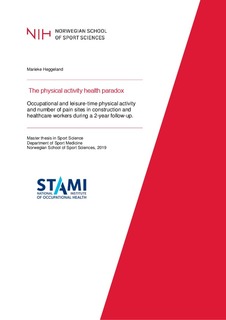| dc.description.abstract | Background: Occupational physical activity (OPA) is often associated with higher prevalence of musculoskeletal pain, while leisure-time physical activity (LTPA) is associated with health benefits. The purpose of this study was to examine this physical activity health paradox by analysing the association between OPA and number of pain sites (NPS), the association between LTPA and NPS, and whether a possible association between OPA and NPS was moderated by LTPA.
Methods: At baseline, 99 workers (construction n=45; healthcare n=54) wore Actiheart® 4 (Camntech, Cambridge, United Kingdom) monitors for 1-4 consecutive days, during work and leisure. As a measure for physical activity (PA) we calculated the average duration (hours) with work ≥33% of the heart rate reserve (HRR), and the average duration (hours) with leisure ≥40%HRR. At baseline and every 6 months for two years, participants reported on NPS (0-9). Confounder adjusted associations between HRR and NPS were examined using linear mixed models for the whole sample and stratified by sector.
Results: OPA measured as time ≥33%HRR was not associated with NPS (β=0.025, 95% Cl -0.29 -0.34) in the whole sample, nor when stratifying by sector (construction: β=0.31 95% Cl -0.26-0.88; healthcare: -0.09 Cl -0.5-0.33). Although not statistically significant, increased LTPA time ≥40%HRR showed a decrease in NPS (β= -0.97 95% Cl -2.0-0.05); the negative association was stronger for healthcare (β=-1.83 95% Cl - 3.7-0.04) than construction workers (β=-0.74 95% Cl -2.0-0.55). LTPA ≥40%HRR did not modify the association between ≥33%HRR at work and NPS (β=-0.03 95%Cl -0.61-0.56).
Conclusions: OPA measured with time ≥33%HRR was not associated with NPS in construction or healthcare workers. In contrast, our results suggest LTPA may be associated with fewer pain sites in healthcare workers. This study does not support the PA health paradox, nor recject it. Therefor there are still requested more research concerning the differential effects of OPA and LTPA on NPS. | nb_NO |
